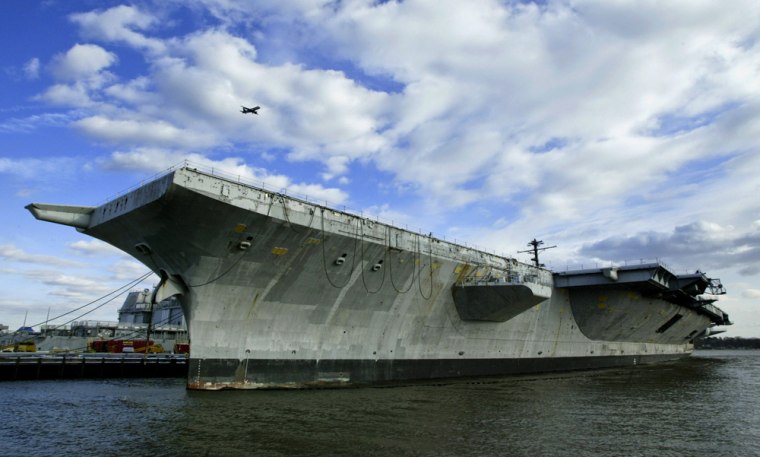The Navy plans to send the retired carrier USS America to the bottom of the Atlantic in explosive tests this spring, an end that is difficult to swallow for some who served on board.
The Navy says the effort, which will cost $22 million, will provide valuable data for the next generation of aircraft carriers, which are now in development. No warship this size or larger has ever been sunk, so there is a dearth of hard information on how well a supercarrier can survive battle damage, said Pat Dolan, a spokeswoman for Naval Sea Systems Command.
The Navy’s plan raises mixed emotions in Ed Pelletier, who served on the America as a helicopter crewman when the ship cruised the Mediterranean shortly after its commissioning in 1965.
He said he was “unhappy that a ship with that name is going to meet that fate, but happy she’ll be going down still serving the country.” Pelletier, of Poughkeepsie, N.Y., is a trustee of an association of veterans who served on the America.
Issues surrounding a vessel bearing the name of its country are often more sensitive than for other ships. In 1939, Adolf Hitler, fearful of a loss of morale among his people should Germany’s namesake ship be sunk, ordered the pocket battleship Deutschland renamed for a long-dead Prussian commander.
Up to six weeks of tests
Since its decommissioning in 1996, the America has been moored with dozens of other inactive warships at a Navy yard in Philadelphia. The Navy’s plan is to tow it to sea on April 11 — possibly stopping at Norfolk, Va. — before heading to the deep ocean, 300 miles off the Atlantic coast, for the tests, Dolan said.
There, in experiments that will last from four to six weeks, the Navy will batter the America with explosives, both underwater and above the surface, watching from afar and through monitoring devices placed on the vessel.
These explosions would presumably simulate attacks by torpedoes, cruise missiles and perhaps a small boat suicide attack like the one that damaged the destroyer USS Cole in Yemen in 2000.
At the end, explosive scuttling charges placed to flood the ship will be detonated, and the America will begin its descent to the sea floor, more than 6,000 feet below.
The Navy has already removed some materials from the ship that could cause environmental damage after it sinks, Dolan said.
No public viewing of experiments
Certain aspects of the tests are classified, and neither America’s former crew nor the news media will be allowed to view them in person, Dolan said. The Navy does not want to give away too much information on how a carrier could be sunk, she said.
Why the America? No other retired supercarriers were available on the East Coast when the test was planned, Dolan said. The others — the Forrestal and the Saratoga — were designated as potential museums, she said.
In a letter to Pelletier’s group, Adm. John Nathman, the Navy’s second-in-command, called America’s destruction “one vital and final contribution to our national defense.”
“Ex-America’s legacy will serve as a footprint in the design of future aircraft carriers,” he wrote.
Although no larger warship has ever been sunk, bigger civilian vessels have gone down. The largest ship in the world, the supertanker Seawise Giant, was sunk by Iraqi warplanes in the Strait of Hormuz during the Iran-Iraq war in the 1980s. Fully loaded, it displaced more than half a million tons. It was later refloated and renamed.
Victim of Cold War budget cuts
The America, which is more than 1,000 feet long and displaces about 80,000 tons, exceeds the size of the Japanese World War II battleships Yamato and Musashi, and the carrier Shinano, which all displaced close to 70,000 tons. The Yamato and Musashi fell to American warplanes, the Shinano to a U.S. submarine.
The America was the third carrier of the non-nuclear Kitty Hawk class, and the first to be retired, a victim of post-Cold War budget cuts after 31 years at sea. It launched warplanes during the Vietnam War, the 1986 conflict with Libya, the first Gulf War, and over Bosnia-Herzegovina in the mid-1990s.
Pelletier and other veterans who served on the America said their farewells in a Feb. 25 ceremony at the ship in Philadelphia. Some artifacts have been removed for museums and veterans’ groups; in addition, Pelletier’s association will place a time capsule on board.
The Navy has several other carriers awaiting their fates. Environmental regulations make breaking warships up for scrap metal largely unprofitable, though some still are dismantled. The Oriskany, a smaller carrier that was commissioned in 1950, is scheduled to be sunk as an artificial reef off the coast of Pensacola, Fla., late this year.
